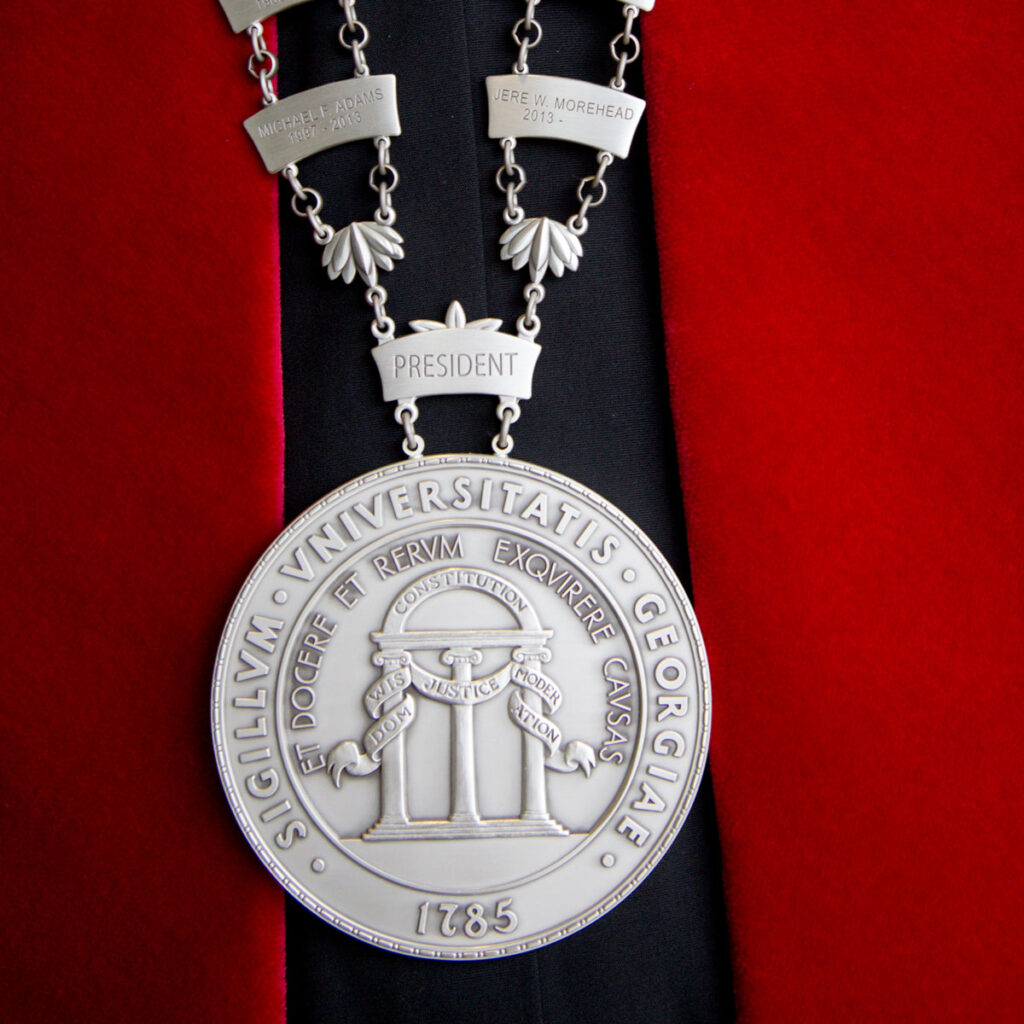
History & Traditions
Regalia

The history of academic dress reaches far back into the early days of the oldest universities. The costume worn today originated in the Middle Ages but was not adopted in this country until the mid-nineteenth century. In the late 19th century, American colleges and universities desired to adopt some suitable system governing academic apparel. Accordingly, on May 16, 1895, representatives from governing boards of various interested institutions met at Columbia University for such a study. From this meeting came the recommendations for the standards from which the academic dress code for the colleges and universities of the United States was established. The code regulating academic dress continues to be administered by an intercollegiate commission.
Gown
The bachelor’s, master’s, and doctor’s gowns differ slightly in pattern only. Bachelors’ gowns have closed fronts and long pointed sleeves. Masters’ gowns have oblong sleeves open at the wrists. The rear part of the oblong shape is square cut, and the front part has an arc cut away. Gowns may be worn either open or closed.
Doctors’ gowns have bell-shaped sleeves, have facings down the front of black velvet, and have three bars of the same across the sleeves. Only the doctor’s gown bears trimmings. These are a velvet facing down the front and three velvet bars across each sleeve; the velvet may be black, or it may be the color appropriate to the subject in which the wearer holds his degree. The robe is worn with a specifically designed hood and velvet academic bonnet.
A fourragere (braided cord) will be worn on the left shoulder of each First Honor Candidate.
Hood

Hoods are the most distinctive feature of the American code and are generally black. All are lined in silk with the official color or colors of the university or college conferring the degree. The University of Georgia colors are red and black. The binding or edging of the hood is velvet with the color indicative of the subject to which the degree pertains.
Cap

The cap is the “mortarboard” type with black cloth cover. The gold tassel may be worn by holders of a doctor’s degree. Candidates should wear their tassels over the right eye until the degree is awarded and over the left eye afterward. The mortarboard on the cap should be parallel to the ground.
Colors
With the exception of the honors tassels, the color of tassels as well as the color of the velvet on the hoods worn by master and doctorate candidates are indicative of the academic subject area. The colors associated with these subjects areas are as follows:
| Subject Area | Color |
|---|---|
| Agriculture | maize |
| Arts, Letters, Humanities | white |
| Business and Accountancy | drab |
| Education | light blue |
| Engineering | orange |
| Fine Arts and Landscape Architecture | brown |
| Forestry and Natural Resources | russet |
| Family and Consumer Sciences | maroon |
| Journalism and Mass Communication | crimson |
| Law | purple |
| Music | pink |
| Pharmacy | olive green |
| Public Administration | peacock blue |
| Public Health | salmon pink |
| Science | golden yellow |
| Social Work | citron |
| Veterinary Science | gray |
Mace and Breastplate
The mace and breastplate have traditionally symbolized leadership and authority since the Middle Ages. The use of the two became a tradition at the University in 1968, when Robert Ebendorf, a University art professor of jewelry and metal, and a former Fulbright Scholar in Norway, was commissioned to create a mace and breastplate to be used at the formal inauguration of President Fred C. Davison as the seventeenth president of the University of Georgia and for future academic processionals on campus.

The 48-inch mace is made of mahogany with the seal of the University on four sides. It is engraved with the name of each School or College at the University of Georgia and the year of its founding. The Grand Marshal leads the academic processional carrying the mace.

The breastplate and chain of office, made to be worn over the academic robe, features a silver medallion of the University of Georgia seal. The chain lists the presidents of the University of Georgia and their years of service. Following a tradition begun in 1968, the breastplate and chain of office is worn by the President of the University at each commencement ceremony.
Gonfalons
Singing of the Alma Mater
The singing of the University of Georgia Alma Mater signals an end to each commencement exercise.
From the hills of Georgia’s northland
Beams thy noble brow,
And the sons of Georgia rising
Pledge with sacred vow.
’Neath the pine trees’ stately shadow
Spread thy riches rare.
And thy sons, dear Alma Mater,
Will thy treasures share.
And thy daughters proudly join thee,
Take their rightful place,
Side by side into the future,
Equal dreams embrace.
Through the ages, Alma Mater,
Men will look to thee;
Thou the fairest of the Southland,
Georgia’s Varsity.
(Chorus)
Alma Mater, thee we’ll honor,
True and loyal be,
Ever crowned with praise and glory,
Georgia, hail to thee.
Written by J.B. Wright, Jr., Class of 1912. Third verse written by Gail Carter Dendy, A.B. ’74, M.A. ’81.
Fireworks
At the conclusion of the Spring Undergraduate Ceremony, UGA graduates are celebrated with a spectacular fireworks display.

Georgia On My Mind
At each Undergraduate Commencement Ceremony, a student is selected to sing “Georgia on My Mind” to celebrate the graduating class.
